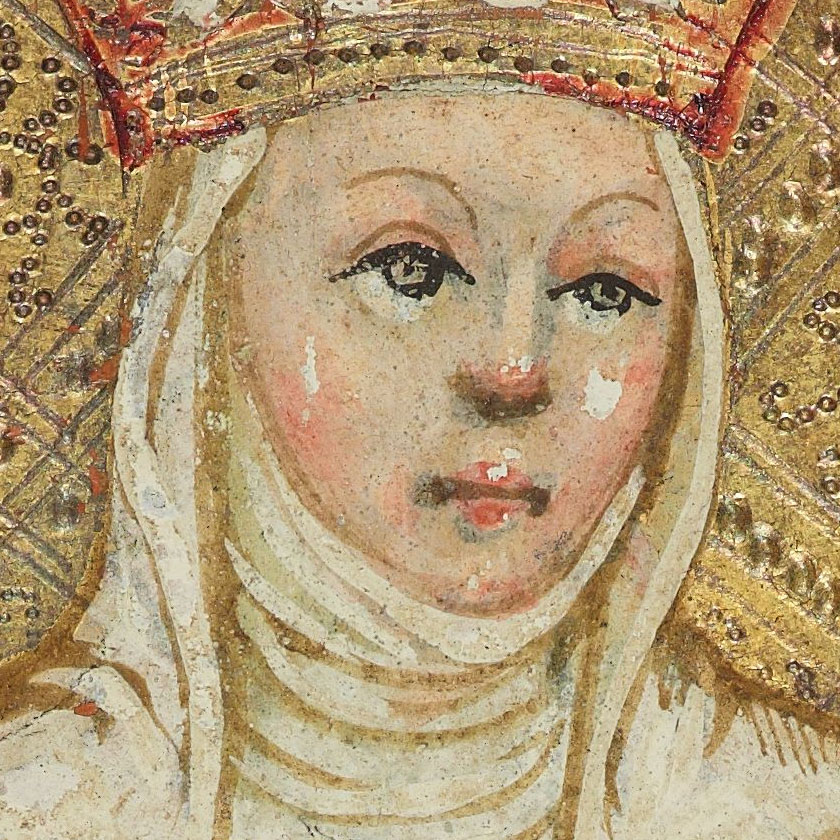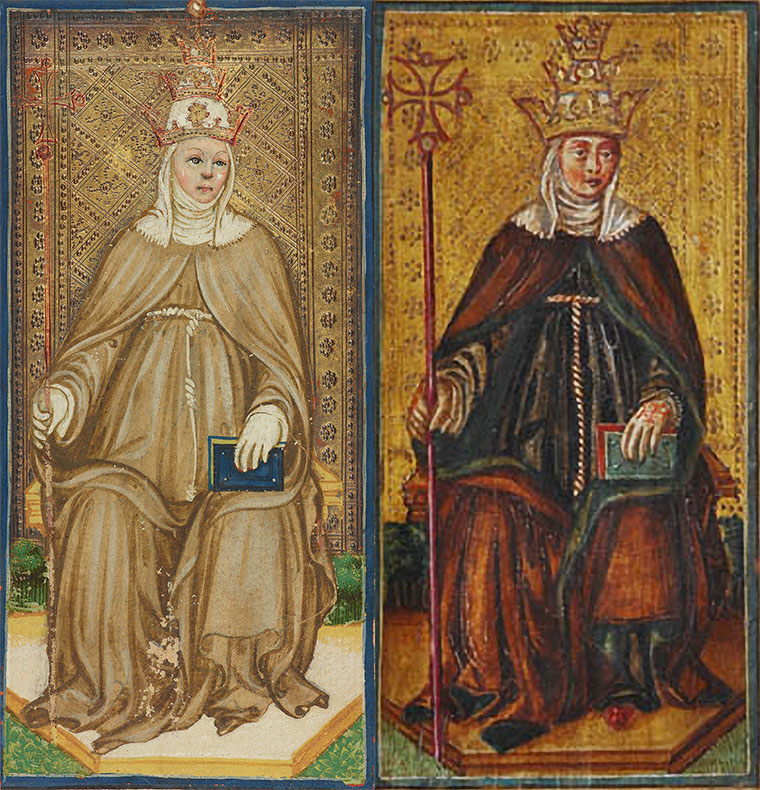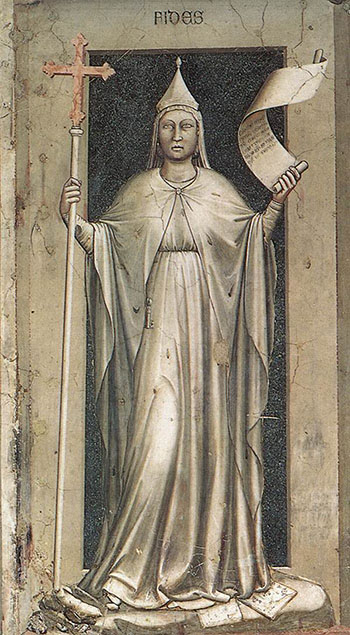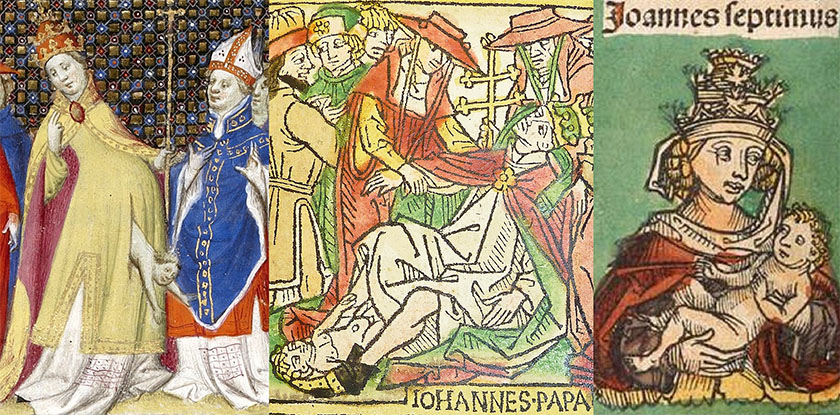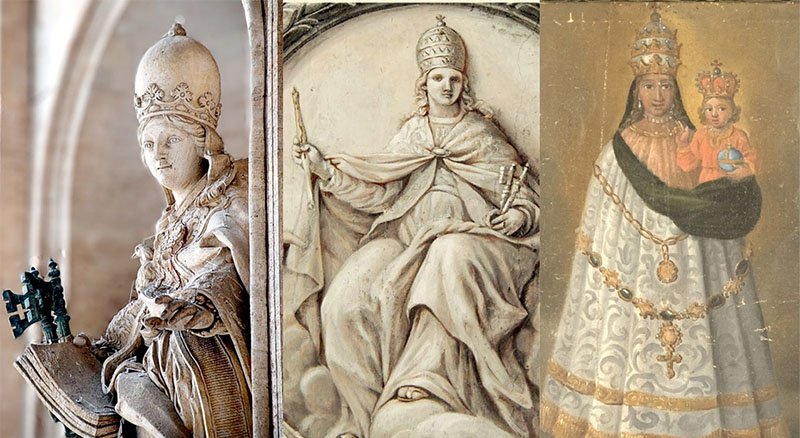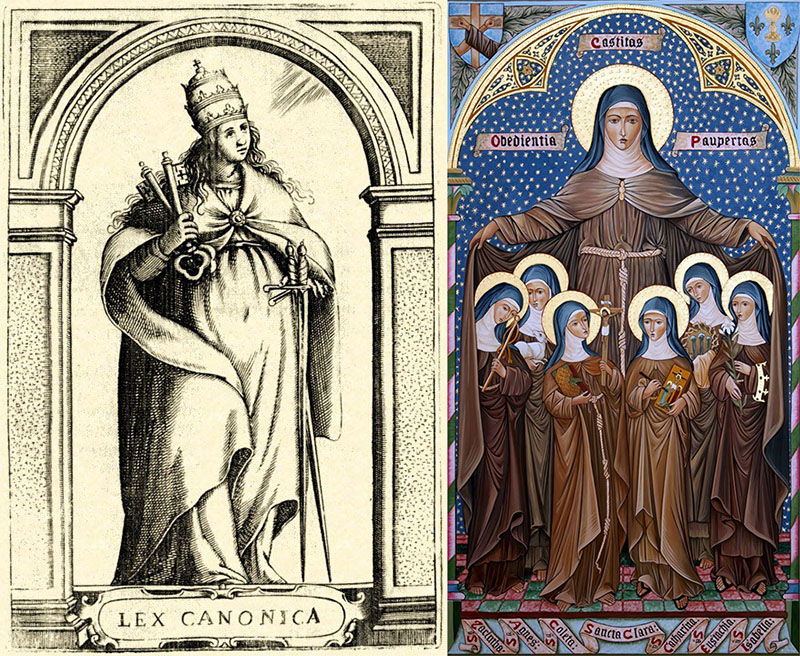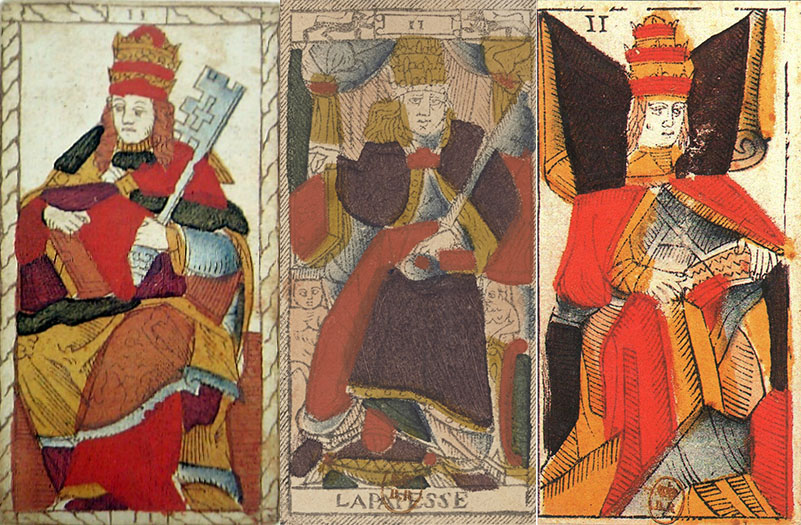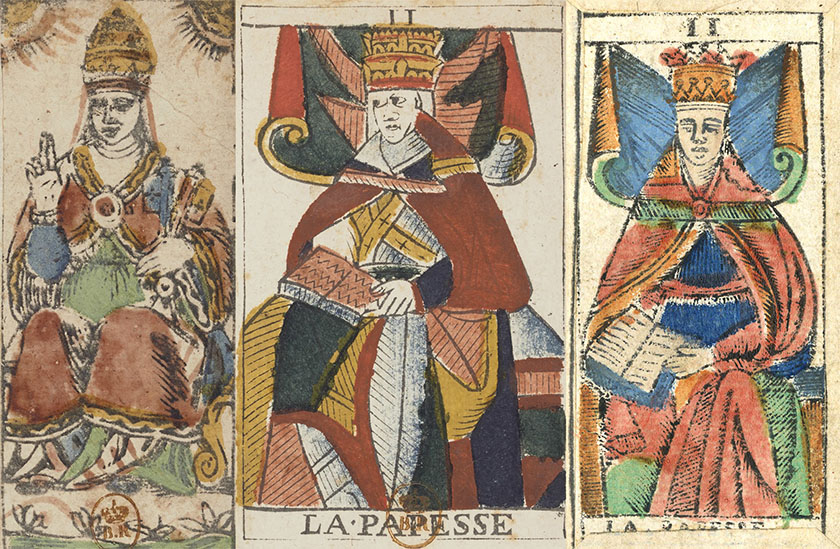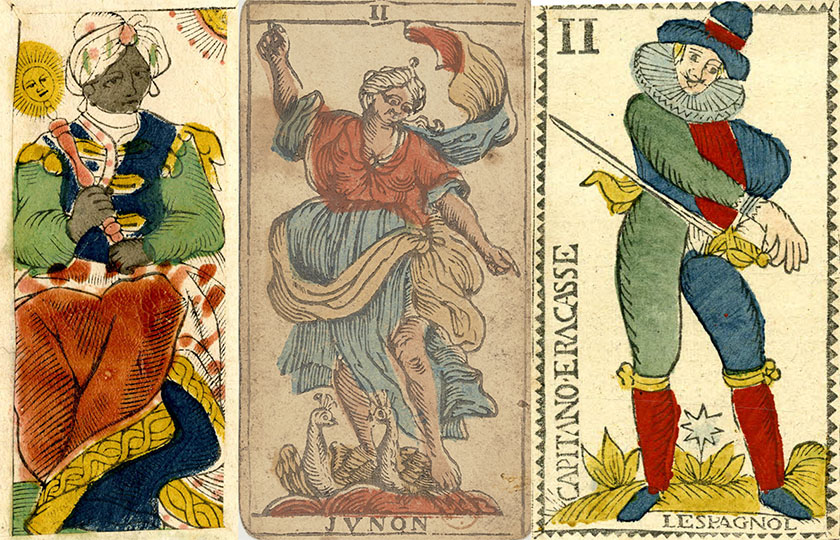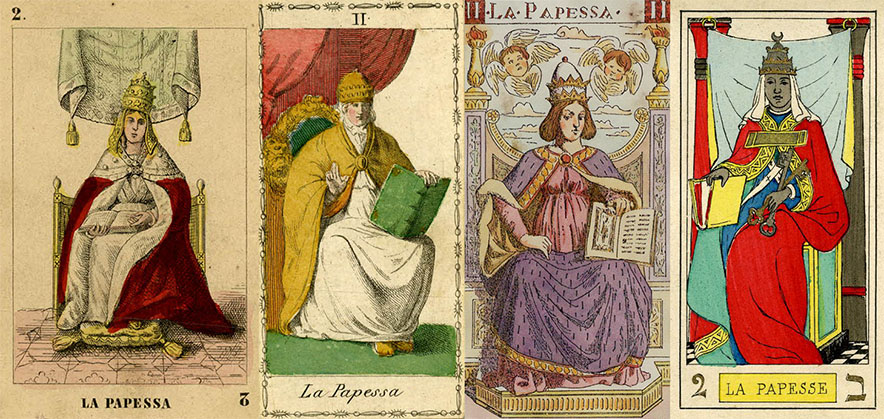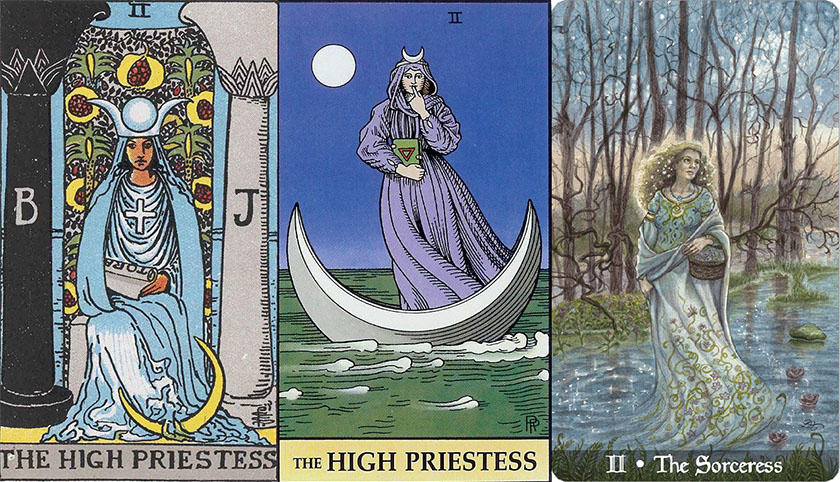THE TAROT WHEEL
LA PAPESSA - THE POPESS
The face of a Holy woman. Her face expresses a deep internal peace, she is in daily communication with God and she does not need anything else. It is the face of someone who has Faith in God, who has acceptance of everything that God has paved for her on her path of life. An internal rest and happiness that cannot be found without this union with God. The card is the Popess from the 1454 Visconti Sforza deck, conserved in the Morgan Library. This card was probably the favorite of Bianca Maria Visconti, who was a deeply religeous woman.
Only two handpainted cards depicting the Popess survived time. At the left we have the 1454 Popess of the Visconti Sforza deck, actually conserved in the Morgan Library, and at right we have a late 15th Century card in exactly the same style, conserved in the Museo Fournier de Naipes de Alava in Northern Spain. While both cards are the practically the same, it will be sufficient to analyze the oldest one.
The Popess is maybe one of the most controversial cards in Tarot history. The Popess, or female Pope, is a non existant institution, while the Pope is a man and married to the Church, not to a woman. In the Roman Catholic Church, the office of priests is strictly reserved to men and priests are not allowed to have a partner nor to have sex. So a Popess cannot exist.
Let us have a closer look at the Popess from the Visconti Sforza deck. We see a woman sitting on a wooden chair in the habit of a nun. On her head she is wearing a nun's headscarf, topped up by a Papal Tiara. On the top of the Tiara a Maltese cross. The Maltese cross is also called the regeneration cross because it symbolizes birth. Around her waist she is having a cord with several knots, a cord typical for the order of Saint Francisus. In this special case it can be associated with the womens department of this order, the Poor Clarissa Order. In her right hand a staff, again topped up by a Maltese Cross, this time with pearls on the four tops. In her left hand a closed book. A closed book symbolizes incomplete knowlege, knowledge you have to seek. The way she is seating, as we could see in the closup at the top of the page, and looking slighty upwards, expresses a great serenity, a great confidence and a deep faith in God. This card is often compared with the fresco of Faith made by Giotto di Bondone, painted in 1306 in the Scrovegni Chapel situated in Padova (Padua) in Italy. For comparison, the fresco is shown here at left.
We do not have any other handpainted image of the Popess, but on several uncut sheets of cards, found in the bindings of old books during their restoration, we also see her appearing. Here below from left to right the Popess from the late fifteenth Century Rosenwald Deck, the Popess from the Budapest sheets, dated around 1500 and the Popess of the Cary Sheet, dated to the very early sixteenth Century.
Three Popesses, all three of them sitting, the first facing us and the two others looking slightly to the right. The Rosenwald Popess has a Tiara on her head, a closed book in her right hand and a key in her left hand. The Budapest Popess is again pictured with a Tiara, this time she has a key (probably, it is hard to distinguish) in her right hand and a staff that looks like a shepherd's crook in her left hand. The Cary Popess has something that looks like a crowned miter on her head, she is holding her right hand in a benediction position and she has the same shepherd's crook in her left hand. She seems to be praying, an open book, probably a breviary, is laying in front of her. A monk is kneeling on her right side as if he is praying with her.
Aside from the slightly different attributes, the women look a lot like a woman disguished as a Pope and are very similar to the Visconti Sforza Popess. The key represents the Key to Heaven, given to the first Pope Peter. The herder's crook is the typical attribute of a bishop. However the Pope is also Bishop of Rome, so he is equally well able of using this attribute. The Popess of the Cary sheet looks with her miter more like a bishop than a Pope.
In Renaissance (and medieval) art, Popesses are very rare. Representing a Popess was considered heretic, so you risked your live while painting her. Before 1500 we only find images of the Popess in illuminated manuscripts and in Chronicles, and then again, only in a very special context. Let's have a look at some of these images.
In the 13th Century we find the first traces of the Legend of Pope Joan. Since her youngest age Joan wanted to be a priest, so she disguished herself as a man, worked very hard and arrived to become a priest. She was so gifted in the doctrine that she passed all grades and finely became elected Pope. Then one day during a procession she gave birth to a child, making it clear she was in reality a woman. She was removed from office, and everything was done to wipe out this shamefull episode in the papacy. We can find the legend back in several manuscripts that date from the 14th or early 15th Century. All three images here above are from this period.
Starting the 16th Century we find depictions of women with papal attributes that are not related to Pope Joan. In the St.Peters Basilic in Rome there is a series of eight statues, seven of them representing the seven capital virtues. The eight statue represents the allegory of the Roman Catholic Church, represented by a woman with Papal attributes. Maria is also sometimes portrayed as a woman crowned with a Tiara, especially the Madonna di Loreto. Here below some of these images.
The left two images are both from the St.Peters Basilic, with the Allegory of the Church (the second one is from the Canons Chapel), and the rightmost image as an example of one of the many depictions of the Madonna di Loreto crowned with the papal Tiara. The conclusion is clear, the "Popess" is part of the Catholic tradition, although she is not allways called a Popess. The strongest image in my opinion is the Allegory of the Church, where the Popess represents the real values of the Church, the Religion as it should be.
During a long time the Popess in the Tarot has been associated with Pope Joan, although not one single card of the Popess shows the Popess in childbirth. Gertrude Moackley suggested to associate the Popess with Manfreda di Pirovana. Manfreda lived in the 13th Century and was a cousin in the first grade of Matteo Visconti. She was a follower of Guglielma di Bohemia, as the story tells it a Bohemian princess who came to the region of Milan to live as a beguine. Guglielma was strongly against the wealthy and corrupt Popes of Rome and preached poverty and charity as essential values of religion. Manfreda was very close to Guglielma. She was Abbess in the Humiliate Order. When Guglielma died, Manfreda became the head of a movement that called themselves the Guglielmites. According this movement, in the same way as St.Peter was the first follower of Jesus Christ, Manfreda was the first follower of Guglielma. They went even so far to declare her Popess, and Manfreda began to lead the Holy Mass. It is clear that the Church did not appreciate this at all. Manfreda and her movement were declared heretic and in 1300 she was burned to the stake with some of her close followers.
But is this enough evidence to associate the Popess on the Visconti Sforza card with the Popess? Bianca Maria Visconti knew the history of her distant relative very well, and she even made big donations to the Humiliate Order in the village of Brunate. In the church of Brunate the "heretic" Guglielma is still venerated as a Saint. But why does the Popess has the cord of the Poor Clarisse Order around her waist? Apparently the story is not finished. In fact, as the story goes, Guglielma had a one year younger sister, Agnes. Both were children of King Ottokar I of Bohemia (who was a direct ancestor of the later Emperors Charles IV and Sigismund). As a child, Agnes was several times engaged, at the age of 3 to a certain Boleslaus, Duke of Bohemia. When Boleslaus died she was engaged at the age of 9 to Henry, the son of Emperor Frederic II. But Henry preferred marrying an other woman. Finally, she was engaged to the Emperor Frederic himself, who was 17 years older than she was. Agned refused this marriage and preferred to offer herself to God and to live a life of austerity and virginity. When the Emperor claimed the bride that was promised to him, she asked Pope Gregory IX to intervene. When the Pope did this, the Emperor released Agnes in 1235 from her engagement. Agnes had a lot of contact with Clara of Assisi, the founder of the Poor Clarrisa order. St.Franciscus of Assisi did die in 1226 and was proclaimed Saint in 1228 by Pope Gregory IX. The closest follower of St.Franciscus was St.Clara who would live until 1250. Thanks to this contact with St.Clara she financed in Prague a Convent for the Poor Clarissa sisters, a convent that started with 5 nuns. Agnes took the veil herself, and soon she was Abbess of this local Convent of the Poor Clarissa Order.. She was dedicated to poverty, helped the poor and was reknowned for her humility. She stayed Abbess until she died in 1282, a couple of months after her one year older sister Guglielma, who had lived the same live of poverty near Milan.
Bianca Maria Visconti was the driving force behind the images on the Visconti Sforza deck. As a Duchess who had diplomatic relations with the Papacy, she could not show her "heretic" relative Manfreda as a Popess on the Trionfi card. The Popess represented in fact the Allegory of the Church, illustrated as a woman with Papal attributes, and she should be shown with dignity. Bianca Maria Visconti probably asked the artist Bonifacio Bembo to portray the Holy Agnes of Bohemia, as the Allegory of the Church. When she was young she had refused to marry to the Emperor, so as such she personified perfectly the Popess who trumped over the Emperor (remember, in the Ferrara order used in that time for the decks with fourteen trumps, including probably the Visconti Sforza deck, the trumps are ordered Empress, Emperor, Popess and Pope). Agnes was also a younger sister of Guglielma, who had such a big influence on the life of Manfreda. In this way she could honor her distant relative without getting in trouble with the Pope. The Allegory of the Church stands for the original values of the Church and Religion, what was exactly the religion preached by both sisters Agnes and Guglielma, each in her proper way. Even if it is not sure that Guglielma was really a sister of Agnes, Bianca Maria Visconti was probably convinced of this relationship, reason enough to portray Agnes of Bohemia of the Poor Clarissa Order on the Popess card.
To finish with the subject here above at left the Dogma of the Church personified as a Popess and at right Saint Clara with six of her nuns. The second nun on the left is Saint Agnes of Bohemia. All of them are clothed alike, identical to the Popess on the Visconti Sforza deck.
Now we have clearly identified the Popess on the Tarot decks as the Allegory of the Church and the Popess on the Visconti Sforza deck as Saint Agnes of Bohemia, we can continue to have a look at the Tarot cards from the 16th Century and later.
Although we don't have images available, we know from literature sources that in Northern Italy Tarot cardmaking maintained itself in the 16th Century especially in the region around Bologna. But the main production shifted to France. Here above from left to right the 1557 Popess from the deck created by Catelin Geoffroy in Lyon, the anonymous Tarot of Paris from the early 17th Century and the Popess from Jaques Vievil, also from Paris and published in the middle of the 17th Century. All three of them are in the tradition of the Allegory of the Church, and they look a lot like the Lex Canonica or the Allegory of the Church in the St.Peters Canons Chapel.
Still three more Popess cards from the 17th Century. From left to right, the Popess on a early 17th Century Tarocchino deck made in Bologna, the Popess created by Jean Noblet around 1559 in Paris, the first of a long series of the Marseille Tarot decks. At right an Italian version of the Marseille tarot with French titles, made by Francesco Berti in the late 17th Century in Bologna. The size proporions of the cards are not correct, the Noblet card is smaller than the two other cards, but the subject here is the image of the Popess, not the deck itself, that's why I've chosen to give all cards on the same line the same height.
The Popess on the Tarocchino deck existed until 1725, when it was replaced by the neutral figure of a Moor. The Popess and Pope cards had exactly the same value, so they are very similar, see the discussion about these two cards in the section dealing with the Pope.
The Tarot of Bologna shown here above is probably based on Tarot decks made in Lyon. Even if we don't have surviving examples, we know that card production was very active in the 17th Century French city of Lyon. The French titles on the Italian made Marseille Tarots correspond to the Lyon made version of these decks (for insiders the Type I Marseille Tarot).
The further we go in time, the less the Popess was associated with the Allegory of the Church, until it was probably completely forgotten. Except for the Marseille Tarot that did not change, for different reasons the image was often replaced. On the Minchiate decks the Pope and the Popess were even completely removed. On the Tarocchino decks designed by Mitelli we see two Popes and no Popess. Several other decks made other replacements as we can see here below.
In Bologna, due to conflict between a cardmaker called Montieri and the Pope (see the section about the Tarocchino decks), the so called "four Popes", that included the Popess, were replaced by the image of a Moor. Above on the left one of the Moors of the deck of Antonio di Maria, dated to the middle of the 18th Century. In the middle we have a card with the Roman Godess Junon, replacing the Popess in the German speaking part of Europe. This card is from a deck made in 1746 by François Laudier in Strasbourg. This type of cards is called the Tarot of Besançon, because the oldest surviving cards are from this French town. In fact, the Eastern part of Europe had become Protestant and images of the Popess and the Pope could not be tolerated anymore. In North Eastern France, Germany and Switserland, all cardmakers adopted the Besançon model. In Northern France and in Belgium, where the Tarot decks were based on the deck of Jaques Vievil, the Popess was replaced by a figure of the Commedia del Arte, Capitain Fracasse, also called the Espagnol. The card shown here is made by the 18th Century cardmaker Jean Gisaine in Brussels.
On the Marseille Tarot and the Italian decks based on this model the Popess persisted over time. Thanks to this influence the Popess made her comeback in other Italian decks. On the left we have two early nineteenth Century Milanese decks, the third card is from the 1893 Vachetta deck, created in Turin, and the rightmost card is the Popess designed in 1889 by the Swiss occultist Oswald Wirth. The Popess is back again and close to the earlier depictions of the Allegory of the Church.
However, the Order of the Golden Dawn did not allow for the Popess in their interpretation of the Tarot. When A.E. Waite published his Raider-Waite-Smith (RWS) deck in 1903, the Popess had been replaced by an Egyptian High Priestess, devoted to the Goddess Isis. And this was the Deathblow for the Allegory of the Church. The symbolism of the Popess died, only to survive in the Marseille Tarot. From left to right we have here the High Priestess on the RWS deck, the High Priestess of the Alchemical Tarot, created by Robert Place in 1994 and the Sorceress of the Fairy Tail Tarot, a deck published in 2009 by Lisa Hunt.
And here we finish our travel through time with the Popess card. Originally the Popess was the personification of the Allegory of the Church, and as such she represented the original values of poverty and charity of the Roman Catholic Church, the Religion such as Jesus Christ would have wanted it to be. On the Visconti Sforza deck this symbolism comes perfectly to life with the image of St.Agnes of Bohemia, sister of Guglielma of Bohemia, an image that is used to personify the Popess and through her the Allegory of the Church. The Popess had a hard life through the ages, many people were unaware of the deep message behind this card and considered her as a heretic symbol. She was replaced in many decks with other images, most of the times far away from the original meaning. The Popess only survived in the Marseille Tarot and in its Italian counterparts, but even there, the original symbolism was forgotten and only few people interpreted this card correctly. The French and Anglo-Saxon occultists expelled the Popess and replaced her with a high priestess. In doing so, they killed the symbolism of the card. For me, the Popess is one of my favorite cards, the Allegory of the Church lives on and continues to radiate the pure values of the original Christian Religion.
